Updated March 2, 2019
I naively thought that buying a crib would be as easy as finding a new sweater. You try on a few different styles and colors, check what materials are used, consider the price and make a decision. Right? Not so much.
Sadly, most cribs on the market contain toxic materials. Since infants are especially vulnerable to toxins, this news is quite concerning. Studies have shown that toxins found in baby products can cause hormone disruption, lowered IQ, reduced fertility, immune dysfunction, cancer and more. These learnings are what inspired me to make a carefully-researched decision about our crib purchase since our baby will be spending most of his time in it during his first few years.
WHAT TO LOOK FOR
First, let’s talk about what to look for in a crib.
Cribs should be:
- Made of sustainable solid wood (not engineered/composite wood – including particleboard, plywood, fiberboard and medium density fiberboard, all which typically contain added formaldehyde.) The wood should be Forest Stewardship Council (FSC) certified to ensure it comes from responsibly managed forests that provide environmental, social and economic benefits.
- Finished or painted with a non-toxic, VOC-free substance (or better yet, get one that’s unfinished). Food grade oil, such as linseed, beeswax or tung oil, is the best option for finishes.
- Lead and phthalate-free. The description should explicitly state this.
- Made in the USA or Europe. Imported cribs, especially those manufactured in Asia (i.e., China, Vietnam, etc.) are not subject to regular third-party oversight or government regulation, so they may not be up to our health and safety standards.
- GREENGUARD Gold certified, which ensures it meets some of the world’s most rigorous and comprehensive standards for low emissions of volatile organic compounds (VOCs) to improve indoor air quality. (Note: This doesn’t always guarantee it’s the greenest choice. Some companies/brands do not feel that paying for this certification is necessary because they know their vendors are complying with the strictest standards.)
Seems simple enough, right? Unfortunately, this criteria is harder to find than you’d think.

Most cribs on the market are structurally safe due to government regulations. However, the government is doing very little to regulate toxins in furniture, especially volatile organic compounds (VOCs). There are currently over 80,000 unregulated industrial chemicals on the market in the US; and the regulations that are in place are considered too lenient by many experts.
Scary, isn’t it?
WHAT TO AVOID
In general, these are the chemicals that should be avoided:
- VOCs (volatile organic compounds) – VOCs are gases emitted from certain solids or liquids, including paints, lacquer and finishes used on cribs. Concentration levels of VOCs are up to 10 times higher indoors than outdoors, and can have both short- and long-term adverse health effects. (The GREENGUARD Gold certification helps screen for VOCs.)
- Lead – Scientists have found that no level of lead is considered “safe” for children. Even small amounts of lead can effect a child’s ability to learn. Lead is commonly found in wood finishes and coatings.
- Phthalates – Studies show evidence that phthalates could affect the reproductive system. Phthalates are used in in hundreds of consumer and household products, including wood finishes.
- Formaldehyde – Formaldehyde is often added to engineered wood as a bonding agent and is present in many glues used for crib construction. It has been classified as a known human carcinogen (cancer-causing substance) by the International Agency for Research on Cancer. It’s important to note that formaldehyde is a chemical that occurs naturally in the environment. The key is to look for no “added” formaldehyde.
- Polyurethane – Polyurethane is notoriously toxic. This substance can be found in some wood finishes.
If you do happen to go with a crib that contains some of these chemicals, another option is to set it outside in the open air for several weeks to allow it to off-gas. You could also open the windows of the nursery, turn on some fans, and allow it to off-gas inside for several months. However, avoiding these chemicals altogether is the safest route.
COMMON PITFALLS AND MISCONCEPTIONS
Now let’s get into the common pitfalls of naïve crib shopping. While these claims may sound good, they don’t tell the full story.
- The “non-toxic” finish claim. Contrary to the claim, non-toxic does not mean “no toxins.” This simply means that the manufacturer has met federal safety standards for the maximum allowable levels of certain toxins. However, those standards don’t prohibit the use of VOCs nor do they adequately regulate heavy metals and other harmful chemicals.
- The “water-based” claim. Although water-based finishes are better than petroleum-based, they can still emit VOCs and contain carcinogens and heavy metals.
- Lead and phthalate SAFE. “Safe” does not mean “free.” Again, this only means that the manufacturer has met the federal safety standards, but the product can still contain low levels of these toxins.
QUESTIONS TO ASK
Calling the manufacturer is the best way to get the most reliable answers. Product labels and descriptions are often not enough. When calling the manufacturer or a store, be weary of customer service representatives who are trying to please their customers. They often don’t know all the details and will tell you what they think will make you happy. Don’t trust these guys! Instead, you should contact the manufacturer directly and speak to a technical expert.
Information to get from the manufactures:
- Directly ask if the wood and finish is lead, phthalate and formaldehyde free if it’s not obvious in the product description.
- If a product claims to use a VOC-free finish, ask the manufacturer about their testing protocols for heavy metals before being sold. Make sure they’re using a third party testing lab.
- Ensure that the manufacturer is testing the finishes on all their production runs. You do not want to end up with a black sheep that’s been contaminated.
- Find out where they get their lumber and if they follow sustainable practices (should be FSC certified.)
- If they are using engineered wood or pressed wood, find out how it is manufactured. In some cases, they may be using recycled wood waste and a formaldehyde-free adhesive (this is okay.)
- Ask if their glues are formaldehyde free. Soy-based or water-based glues are typically free of harmful chemicals.
It’s also helpful to read the Q&As on the seller or manufacturer’s site carefully. Many times, you’ll find that other savvy parents have already asked these questions.
RECOMMENDED CRIBS
Okay, so now you’re probably wondering what brands meet all of the criteria listed above. I wish I had a simple answer, but unfortunately I learned that finding a crib is a labor-intensive research project. Thankfully, some other diligent bloggers have already done some of the legwork.
Here’s the deal. A sustainable solid wood crib is the best way to go, but it will typically cost $700-$2,000. While this is a big investment, it will be safer and more durable than cribs made with engineered wood. You can also rest assured knowing that your baby isn’t surrounded by toxins.
If you can’t find a solid wood option that meets your needs, the next best option is one that is made with a combination of solid wood and low-emission engineered wood (one that meets or exceeds the CARB II emission standards).
Here are some of the retailers and brands I explored before making our purchase.
Retailers
Finding a truly solid wood crib with a food-grade oil finish and formaldehyde-free glue is a difficult task. The company needs to be transparent, use trustworthy suppliers and have a successful track record to earn my trust.
The Non-Toxic Nurse recommends cribs from Green Cradle, which is a store that specializes in offering truly organic and all natural products that contain no toxic chemicals. Their goal is to offer products that make it easy for people to make safe choices. Prices for their cribs range from $995 for the Gratitude Slat Crib to $2,000. Although a pricey proposition, these cribs are among the few that are made of 100% solid wood with all natural chemical-free finishes. Their transparency is quite impressive, which scores them major points!
 Baby Eco Trends is another retailer that offers solid wood non-toxic furniture that does not use plywood, veneer, particleboard, pressed wood and MDF. All of their cribs are handmade by local suppliers in the USA. They offer the option to choose a hardwood and a formaldehyde-free finish or paint. Prices range from $1,000 – 2,000, but many can convert into a toddler bed and full bed which helps justify the high price tag. This Amish 4 in 1 convertible crib ($1,240) is one of the many options.
Baby Eco Trends is another retailer that offers solid wood non-toxic furniture that does not use plywood, veneer, particleboard, pressed wood and MDF. All of their cribs are handmade by local suppliers in the USA. They offer the option to choose a hardwood and a formaldehyde-free finish or paint. Prices range from $1,000 – 2,000, but many can convert into a toddler bed and full bed which helps justify the high price tag. This Amish 4 in 1 convertible crib ($1,240) is one of the many options.
 Sprout “does the research so you don’t have to.” Any company that does that wins my undying love. Their mission is to help you choose the safest and healthiest products for your child. They take this seriously by meeting with industry leaders to stay on top of the latest scientific data, research and studies. Their products are natural, organic and free of toxics and must meet their stated criteria (which includes being cute and stylish.) This Oeuf Sparrow is offered, as well as others by Newport Cottages, Stokke and Babyletto. (Note: Not all of these options are solid wood, but they are low emission products.)
Sprout “does the research so you don’t have to.” Any company that does that wins my undying love. Their mission is to help you choose the safest and healthiest products for your child. They take this seriously by meeting with industry leaders to stay on top of the latest scientific data, research and studies. Their products are natural, organic and free of toxics and must meet their stated criteria (which includes being cute and stylish.) This Oeuf Sparrow is offered, as well as others by Newport Cottages, Stokke and Babyletto. (Note: Not all of these options are solid wood, but they are low emission products.)
Brands
When this article was originally posted (on August 20, 2013), only a few mainstream brands met my criteria. Over the past five years, however, many brands have caught onto parents’ demand for non-toxic products. Most well-known brands have obtained the GREENGUARD Gold certification by improving the health and safety of their products. Finally, brands are shaping up.
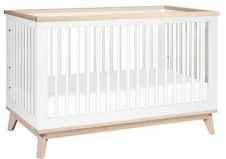 Babyletto recently announced they are working with the their factories increase the number of their cribs that are GREENGUARD Gold certified. This is a brand that is truly standing behind their commitment to safety. They have a wide selection of GREENGUARD Gold certified cribs, including the Scoot ($350), Hudson Crib ($380) and the Lolly ($400) . I commend Babyletto for taking these steps to make safer, cleaner and greener products.
Babyletto recently announced they are working with the their factories increase the number of their cribs that are GREENGUARD Gold certified. This is a brand that is truly standing behind their commitment to safety. They have a wide selection of GREENGUARD Gold certified cribs, including the Scoot ($350), Hudson Crib ($380) and the Lolly ($400) . I commend Babyletto for taking these steps to make safer, cleaner and greener products.
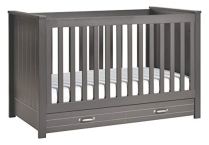 DaVinci is also offering a slew of GREENGUARD Gold certified cribs, including the Autumn ($230), Piedmont ($260) and the Asher ($250). While these cribs are manufactured in Asia, their commitment to making GREENGUARD Gold certified products is a step in the right direction. At least parents rest assured knowing that these cribs are screened for 360 VOCs and over 10,000 chemicals.
DaVinci is also offering a slew of GREENGUARD Gold certified cribs, including the Autumn ($230), Piedmont ($260) and the Asher ($250). While these cribs are manufactured in Asia, their commitment to making GREENGUARD Gold certified products is a step in the right direction. At least parents rest assured knowing that these cribs are screened for 360 VOCs and over 10,000 chemicals.
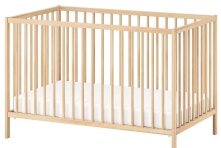 Even brands like Ikea are offering solid wood cribs. A popular low-cost option is the Ikea Sniglar ($165). The entire crib, including the bed base frame and bed rails, is made of solid beech wood. (Tip: This would also be a great crib for a family member or friend’s home where you’ll be staying if you don’t want to spend a fortune on another quality crib.)
Even brands like Ikea are offering solid wood cribs. A popular low-cost option is the Ikea Sniglar ($165). The entire crib, including the bed base frame and bed rails, is made of solid beech wood. (Tip: This would also be a great crib for a family member or friend’s home where you’ll be staying if you don’t want to spend a fortune on another quality crib.)
 Oeuf is higher-end brand that offers safe and healthy choices. This Classic Crib ($970) is made of solid birch and eco-MDF that is made from recovered wood fibers and adhesive that contains low levels of formaldehyde. All Oeuf’s furniture is made of sustainable, premium materials that is ethically produced in Latvia. Their cribs are also GREENGUARD Gold certified.
Oeuf is higher-end brand that offers safe and healthy choices. This Classic Crib ($970) is made of solid birch and eco-MDF that is made from recovered wood fibers and adhesive that contains low levels of formaldehyde. All Oeuf’s furniture is made of sustainable, premium materials that is ethically produced in Latvia. Their cribs are also GREENGUARD Gold certified.
This is quite an extensive list. But which cribs were our contenders? Here you go:
Contenders
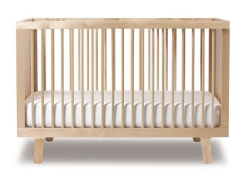 Oeuf Sparrow ($700-800) – We were attracted to the style of this crib and it fit within our price range. We also liked that it was made in Europe where safety standards are more stringent. Although the crib is not 100% solid wood, it is made from locally sourced solid birch and Baltic birch plywood that exceeds the CARB 2 emissions standards. I felt confident that this would be a smart and safe choice for our baby.
Oeuf Sparrow ($700-800) – We were attracted to the style of this crib and it fit within our price range. We also liked that it was made in Europe where safety standards are more stringent. Although the crib is not 100% solid wood, it is made from locally sourced solid birch and Baltic birch plywood that exceeds the CARB 2 emissions standards. I felt confident that this would be a smart and safe choice for our baby.
 Babyletto 3-in-1 Hudson Crib ($379) – The price and modern look was right ($395), but I wasn’t sold on a few of the details. Even though the crib is GREENGUARD Gold certified, it is made in Taiwan and contains MDF and paints/finishes that are “lead and phthalate SAFE” (not FREE) with undetectable levels of formaldehyde. I preferred to have a crib that is completely free of these chemicals.
Babyletto 3-in-1 Hudson Crib ($379) – The price and modern look was right ($395), but I wasn’t sold on a few of the details. Even though the crib is GREENGUARD Gold certified, it is made in Taiwan and contains MDF and paints/finishes that are “lead and phthalate SAFE” (not FREE) with undetectable levels of formaldehyde. I preferred to have a crib that is completely free of these chemicals.
 We also considered the Kendall Fixed Gate Crib ($599). Just out of curiosity, I contacted Pottery Barn to ask if the finish for this crib was lead and phthalate free. I found their answer to be a bit suspicious:
We also considered the Kendall Fixed Gate Crib ($599). Just out of curiosity, I contacted Pottery Barn to ask if the finish for this crib was lead and phthalate free. I found their answer to be a bit suspicious:
“All PBK products meet or exceed US, Canadian and recognized industry standards, as well as Williams-Sonoma testing standards, for safety and toxicity (including lead). All PBK products are tested by an independent laboratory to ensure that your child is using products that meet our high PBK standards. We do not share specific test results, as they are a proprietary part of our development process.”
Their safety test results are proprietary? No thank you. I need transparency.
OUR WINNER (MY RECOMMENDATION) – Nest Crib from Room & Board ($699) 
Not only did we love the classic look of this crib, but it also met all of our standards. El Greco Woodworking was one of the most transparent companies I’ve come across during this process. I spoke with the owner and learned that their cribs have NO lead or phthalates. They buy their lumber from the Appalachian Hardwood Manufactures, Inc, which is a sustainable and carbon negative company (verified by the U.S. Forest Service). All of their coatings are non-toxic and free of lead and phthalates. After their lacquer coating cures, which takes 30 days in warm, moving air, it no longer off-gases because the solvent has dissipated and the coating becomes chemically inert. Even the MDF they use on other cribs is Certified Green, meaning it has no added formaldehyde. Everything is crafted in their factories from rough lumber to the finished product. The entire crib, including its parts, are made in the USA. (Note: You might be wondering why I chose a crib that is not GREENGUARD Gold certified. Room & Board has chosen not to purchase this certification because they know their vendors and the products they use to create their furniture. After doing my research, I trust the products coming from El Greco Woodworking.)
A FEW CLOSING THOUGHTS
Whatever decision you make, it should be based on your personal preference and needs. There are many factors to consider when buying a crib, including price, style, quality, durability, convertibility into a toddler bed, etc. I hope you find these suggestions helpful as you begin your crib hunting process. Good luck!
All comments are welcome and encouraged. We can all learn from each other.
See more on this topic in How to Create A Healthy, Non-Toxic Baby Registry


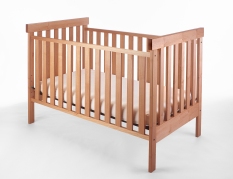
Hello. Thanks for such an informative post about wood crib options! I’m loving the vintage iron crib look, however, and having a VERY hard time finding information about the safety of these cribs as related to the paint or coating! Presumably, 1/2 of the job is already done b/c you don’t have to worry about MDF or veneer woods. But the paint or coating on the metal could still have VOC’s etc, right? Do you know of any manufacturers for metal cribs with safe paint ratings??
Thanks in advance for any advice!
Thanks for your comment. It’s definitely a battle getting information from manufacturers. Most paints these days do not have VOCs, but you still should check to ensure this is the case. Buying a crib through seller who will give you third party testing results is often the best way to get reliable information. You can also contact the manufacturer directly. I hope this helps. Good luck!
Pingback: Nontoxic Crib - Live Toxic Free
Hi Kelly,
Thank-you so much for your posts and information! It is truly helpful! Would you have a recommendation for a rocking chair/baby glider for the baby’s nursery? I’m assuming one that is lead, VOC, and phalate free would be safe? Would anything that is Greenguard Gold Certified be safe?
Thanks so much!!!!
Ali
Hi Ali,
Yes, you got it! All of those chemicals mentioned are ones you’d want to avoid. I’d recommend evaluating the chair/glider with the following criteria:
1) What type of exterior materials are used? Natural fibers or materials, such as wool, organic cotton or wood are great choices. Materials that are OEKO-TEX Standard 100 and GOTS-certified are best. If it is made of wood, check to make sure it is solid wood and the finish is non-toxic, water-based and VOC-free.
2) What type of filling or padding is used? Typically, foam should be avoided because most is petroleum based (and emit VOCs) and may contain flame retardants. If plant-based foam is used, confirm what percentage is actually plant-based vs. petroleum based.
3) Look for independent certifications like Greenguard Gold.
Monte Design is a responsible manufacturer. Their models are very expensive, but this gives you and idea of what to look for: https://montedesign.com/pages/responsible-manufacturing
I hope that helps!
Hi Kelly,
Thank-you so much! I’ll do some research, and if I am able to find a good fit, I’ll surely let you know!
Ali:)
It was my pleasure, Ali! Yes, please keep me posted on what you find. I’m sure other readers would love to hear your recos!
Pingback: Nontoxic Crib - Debra Lynn Dadd
Hi, the recommended Nest Crib I notice is not greenguard gold certified. I am deciding between the Nest you linked to and the Ouef Sparrow Crib. The sparrow crib doesn’t disclose if the glue they use is water-based but it IS greenguard certified. The Nest seems more transparent but they are not GGG certified. What do you think is the better option?
Hi Stephanie,
These are both great options! If you look in the Q&A section for the Nest crib, some consumers asked similar questions. One of the answers confirms that the lacquer is Greenguard Gold Certified (https://www.roomandboard.com/catalog/kids/cribs-and-changing-trays/nest-crib). You many want to look through some of these Q&A’s for both cribs to as you’re making your decision. I hope this helps!
Hi Kelly, omg thank you for making this blog. I’m a first time Mom (baby is currently in my ute) and I’m a neurotic personal already when it comes to green things, but it is so wonderful to not have to burn my eyeballs out researching so much. Quick question. What other crib do you recommend besides the Nest Crib? I know there were contenders but none of those seemed as appealing and plus, a lot of those links no longer work.
Hi Jami,
I’m so glad this is helpful! Admittedly, this hasn’t been updated for a while since I’m no longer in the market for a crib. Thank you for letting me know a few of the links aren’t working. A few others you may want to consider are the Babyletto Modo, which is GREENGUARD Gold certified: https://www.target.com/p/babyletto-modo-3-in-1-convertible-crib-with-toddler-rail/-/A-17293852?preselect=75455945#lnk=sametab or the Oeuf (https://oeufnyc.com/collections/cribs-conversion-kits/products/sparrow-crib?variant=42463655113). If neither of these are what you’re looking for, you could search for “non-toxic” or “solid wood” cribs to see what comes up and then read through their descriptions. I hope this helps – and good luck with your search!
Your blog is so helpful! I was going to go with your recommendation, but the Nest crib contains MDF now. Website says: Mattress Support Details: low-emission MDF & solid wood. What would you pick as second choice?
HI Kimberly – Thanks for your comment. Yes, the Nest crib does have MDF (as stated in the post), but it’s Certified Green and contains no added formaldehyde. There are many other options listed within the article. I’d encourage you to check those out. There are a lot of great options out there!
First time mom overwhelmed that cribs can be toxic?! What?! Thank you for your article! Did you look in to the Karla Dubois brand. I’m wondering how their cribs compare to Babyletto. Looks like their finishes are lead and phalate FREE.
Hi Caitlin – Thank you for your comment! I spent some time looking at Karla Dubois cribs and they seem to be a great option. Some of the products are lead and phalate “safe” (vs. free) but most seem to be “free” of those toxins. They have a nice brand story and it’s reflected in their products. You may want to ask about the paints and glues used. The cribs are very similar to Babyletto’s. I hope that helps. Good luck!
Hi Kelly,
I did a lot of research into the cribs you mentioned and found some interesting things. I looked into the Sherwin Williams lacquer used by El Greco woodworking, and although tots formaldehyde free, it does contain many other toxins. Here is the link to the safety data sheet: https://www.paintdocs.com/docs/webPDF.jsp?SITEID=SWPCGWOOD&doctype=SDS&prodno=035777137390&lang=2&cntry=US
It confirms that it is almost impossible, if not impossible, to find products that contain 0% toxins.
The second thing I noticed is obscurity with Babyletto. Although they mention they are lead and phthalate SAFE, there is a section on the home page (I believe the home page but it could be another) that states in a summary paragraph that their products are lead and phthalate FREE. I’m wondering if it’s because their percentage levels for chemicals tested including phthalates are so low: <.001% although the phthalates are undetectable. I’m wondering if once it’s undetectable, you can say it is essentially free. Just some things to consider. I look forward to hearing your thoughts. Thanks!
Hi Rochelle,
Thanks so much for sharing this information. I had the exact same concerns as you about the toxins in the lacquer. I called El Greco and had a lengthy conversation with them about this issue. I learned that they allow the lacquer to off gas in an open air warehouse for several weeks so the toxins become inert. They told me that was how they were able to have a safe product without compromising quality.
Great find on the Babyletto site. I do believe that companies are allowed to use the “FREE” claim if the levels are undetectable. I would like to gain some clarity on that, however.
Thanks for your comment, and please keep them coming if you find anything else!
Thank you so much for taking the time and posting all your research. Being as “GREEN” as possible is always important to me. It looks like the best option is the Oeuf Sparrow but the only thing that is throwing me off is that it says it’s made with plywood.
Hi Samantha – Thanks for your comment. That’s a valid concern. Plywood can actually be a sustainable and eco-friendly material depending on the process used. If the wood is FSC certified and the glues are formaldehyde free, then it’s a safe option. Given that the Oeuf Sparrow is Green Gold Certified, this means that it does meet rigorous environmental standards. You may want to look at a few other options just to make sure this is the best choice for you. I hope this helps!
Extremely helpful article! Thank you! Nice to know I’m not the only one worries about this stuff. Like, every little purchase becomes a huge research project as if we’re Ph.Ds in baby-ology.